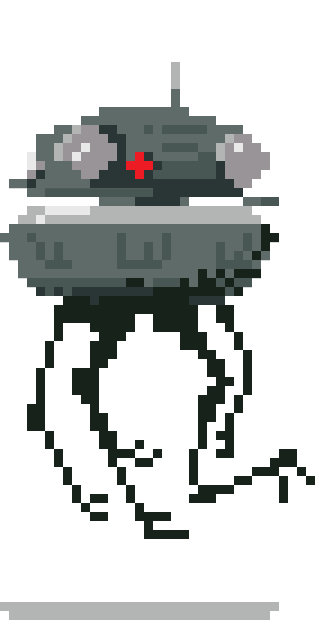Star Wars: Rogue Squadron
PC - LucasArts/Factor 5, 1998
The Star Wars special editions had just been released in cinemas, and Episode 1: The Phantom Menace was about to disappoint millions of fans everywhere. Into this gap stepped Rogue Squadron, one of the last pieces of original trilogy media allowed to continue into the prequel era. Simplified from the X-Wing games, this arcade flight sim had an storied development that pushed technology much more than it may be given credit for.
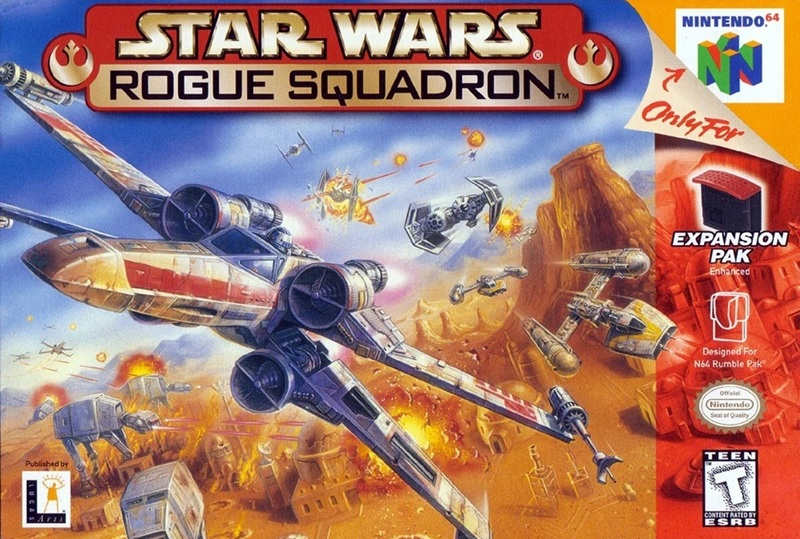
Factor 5's big break came when they were threatened with legal action by Activision over an R-Type clone they had made. To avoid being sued, they were to work on Activision's Amiga R-Type port, which Julian Eggebrecht described as "a dream come true". Up until 1998, Factor 5 continued to work mostly on ports, including porting many LucasArts games to Nintendo and other platforms. Factor 5 developed the Super and Mega sequels to Turrican, and also created Indiana Jones' Greatest Adventures (1994) which I found to be one of the better Indy games out there.
Meanwhile, LucasArts were fresh off the release of Shadows of the Empire (1996), with particular praise given to its Battle of Hoth snowspeeder level. Mark Haigh-Hutchinson of LucasArts says they wanted to base an entire game around the successful sequence. Factor 5 had been pitching a flight-sim shooter as a sequel to LucasArts game Rescue on Fractalus (1985), a sort of cross between Terminal Velocity (Terminal Reality, 1995) and Choplifter (Dan Gorlin, 1982). The stars aligned and Rogue Squadron was born.
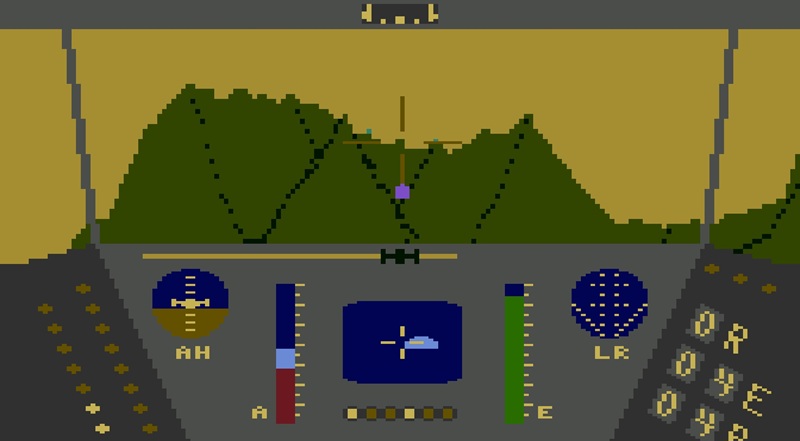
Where players of previous LucasArts flight-sims X-Wing, TIE Fighter and X-Wing vs. TIE Fighter (Totally Games, 1993, 1994, 1997) had the freedom of space to fly around in, Rogue Squadron was planet-bound. While technically 6 degrees-of-freedom (most of the ships can do a loop-de-loop or roll upside-down) the flight ceiling is quite low. A separate 'roll' button means that you can roll or turn, but not both, so most of your time is spent manoeuvring horizontally above the ground.
There were a glut of similar games in the 90s, especially on PC. Descent (Parallax, 1995) was an underground 6DOF shooter, while Terminal Velocity is the smoother combat flight sim. Incoming (Rage, 1998) and to a lesser extent G-Police (Psygnosis, 1997) were graphically fancy similar games of the time and probably contributed towards Rogue Squadron's lukewarm reception on the PC. Consoles meanwhile didn't have any of the X-Wing games, or full versions of the above, although they did have a stated inspiration for Factor 5, Star Fox (Nintendo, 1993), similar but with gameplay firmly on-rails.
What none of those games had was the Star Wars license.
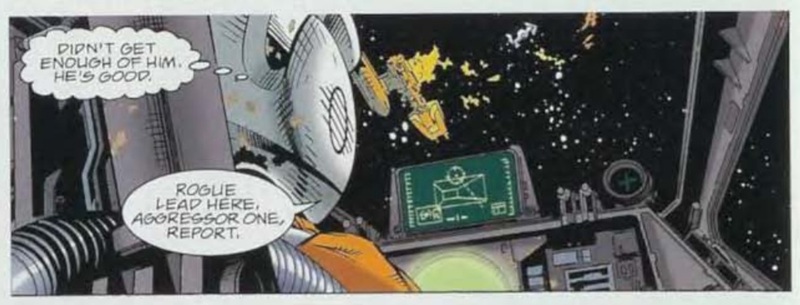
The LucasArts Lore
While the technology was already underway, LucasArts began work on the setting and story. LucasArts vetoed recreating movie scenes, so Lead Level Designer Kevin Schmitt was brought in to write the background. In an interview he recalls choosing the 1995 and 1996 Expanded Universe (now "Legends") Rogue Squadron comics and books as the perfect setting. Ironically this comes full circle, as the first book, X-Wing: Rogue Squadron, opens with a scenario from the X-Wing game, specifically Mission 4: Protect the Medical Frigate.
Originally the protagonist was to be Rookie Two, the successor to Rookie One from Rebel Assault 1 and 2 (LucasArts, 1993, 1995) but LucasArts softened on using movie material as production went on, allowing Luke Skywalker himself to be used, with lots of other characters from the books and films included.
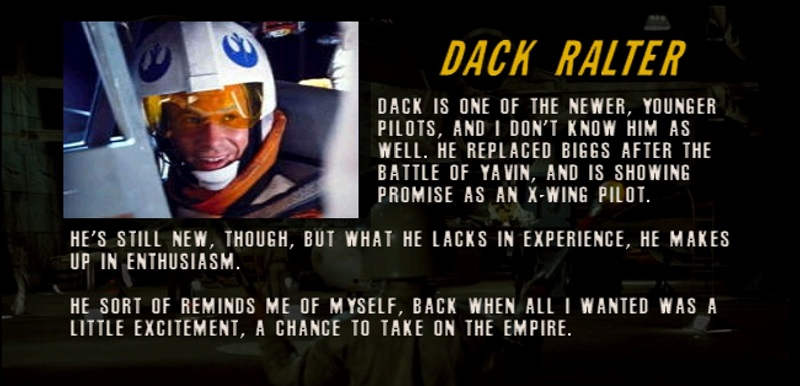
The game is set six months after the Battle of Yavin, between A New Hope and The Empire Strikes Back, similar to SotE being set between Empire and Return of the Jedi. Your crack team of pilots assembled by Luke Skywalker gears up for various missions across the galaxy. They happen upon an Imperial officer who defects to the Rebellion and more adventures ensue.
LucasArts also designed the 16 missions across four chapters, each with their own Star Wars opening crawl. Locations are varied across snow, desert, jungle, moons, with familiar locations, vehicles and characters from the movies and the Extended Universe, many appearing in a game for the first time.
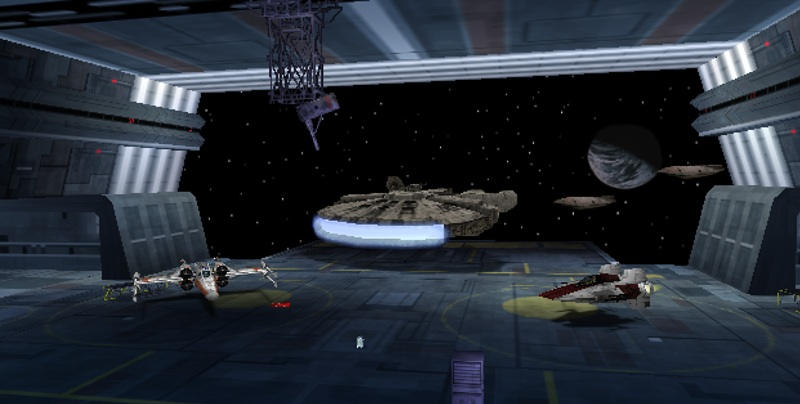
According to Schmitt, LucasArts knocked out the story and level design in 9 months of crunch, helped along by their passion for Star Wars and the project. While LucasArts provided their gaming knowledge and industry experience, Factor 5 were seemingly interested more in the tech than the games. F5 took the technology and tools part of the workload; the programming magic that helped make Rogue Squadron special in many gamers' hearts.
Peer Reviews
What does make Rogue Squadron special in a sea of amazing LucasArts games of the time, as well as some similar games in the genre?
The technical feats are certainly an aspect, although the game fared far better on console than on PC, where it had already been surpassed in graphics and audio prowess.
Wing Commander was an early player in the 90s sci-fi flight-sim boom, but X-Wing and TIE Fighter had already achieved what some still hold as the gold standard in space combat games, as well as the ultimate Star Wars immersive experience. It also had iMUSE (Interactive Music Streaming Engine), which already fulfilled the promise of F5's dynamic music system in Rogue Squadron. X-Wing vs. TIE Fighter already surpassed F5's game in terms of scale and graphical quality.

These games were complex, however, with energy and shield management systems, deep lore, and required gamers to be able to navigate and orient themselves in 3D space. They also begged to be played with a joystick, so even those who found them accessible could not necessarily enjoy it as intended.
On the arcade sim front, there were still some other contenders. Descent groundbreaking as a 3D, 6DOF FPS, but was fully indoors and players could find it confusing (or dizzying). Terminal Velocity was a combination of X-Wing and Descent, and probably the closest comparison to Rogue Squadron in look, feel and gameplay. It's fast frantic fun and many gamers will have memories of at least playing the shareware version to death as they did with Doom and Quake. It also has huge open levels, much larger than Rogue Squadron but it lacks charisma, being very generic sci-fi.
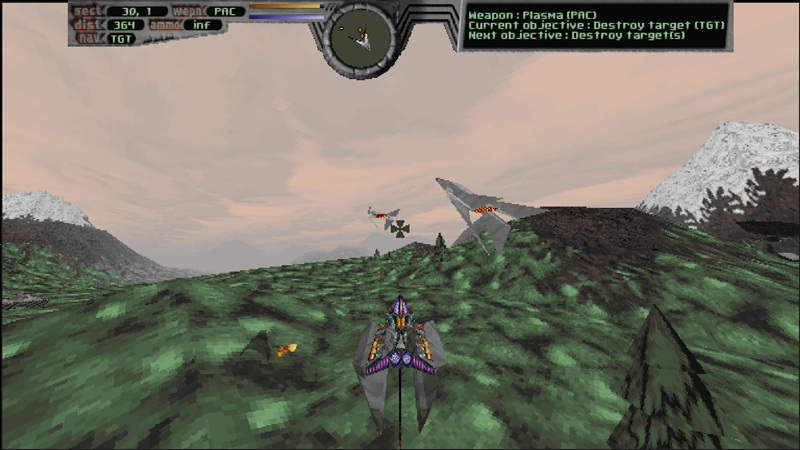
Incoming (Rage, 1998) was also very close to Rogue Squadron, and was blowing gamer's minds with the newest 3D graphics of the time. Made to be bundled with 3dfx graphics cards, it was primarily first-person, but did have a third-person mode. Despite its flashy graphics and many gimmicks such as RTS elements and turret levels, it reviewed slightly lower than Rogue Squadron on PC
And those reviews were only on PC, as neither were found on consoles. What consoles did have was Star Fox 64, a stated inspiration of Factor 5, which already had an existing universe and adoring fans from the SNES version. While Star Fox 64 was on-rails like its predecessor, the N64 version did have 'All-Range Mode', allowing the player free-roaming in certain areas and in multiplayer arenas. Now we're getting very similar to Rogue Squadron. In fact we're coming full circle again, as the Arwings of Sta Fox were based on X-Wings. Released more than a year before Rogue Squadron and mostly being on-rails, it wasn't really a competitor. In fact I'm sure most people who had one game also had the other, I know I did.
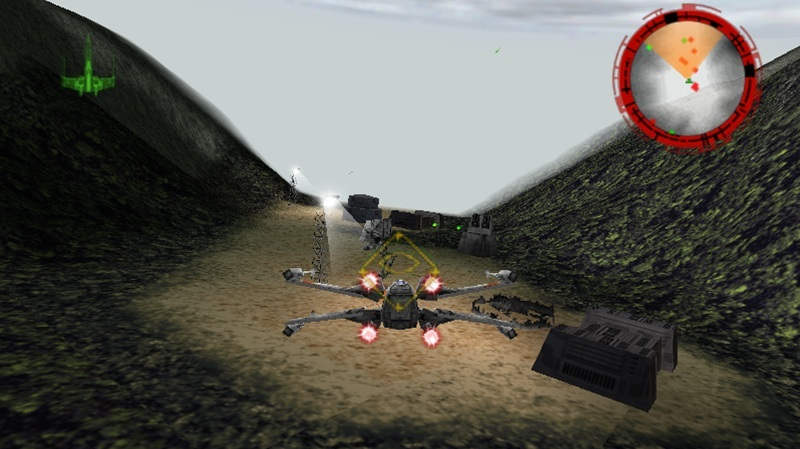
Although Star Fox 64 didn't (and probably could never) surpass the original, it still reviewed much better than Rogue Squadron at the time, although I would say history, multiple sequels, and a bigger IP have perhaps given Rogue Squadron a more lasting impact in gaming history than Star Fox 64.
In the year of Ocarina of Time, Half-Life, and the Western releases of Pokemon Red and Blue, it was a tough year to be in the history books. Rogue Squadron was still one of the top selling games upon release, with Eggebrecht quoted as saying it sold "about 100 times better than anybody expected."
Gameplay
It’s easy to see why, even without the Star Wars license. Unlike the X-Wing games, It’s accessible, fast and intuitive, you will immediately be swooping around planets having a blast. The levels are limited in area, but many are large and interesting, I often failed a mission because I flew off somewhere interested and was having fun while my squadron got shot down. Each mission is punctuated with cinematic in-engine cut-scenes which keep the story going and give you your objectives, as well as looking cool. It's also cool to see civilians walking around town, or passing high over familiar landmarks from the films. They are just little sprites or simple models but at the time it made the world feel very alive at the time, and it does help the feeling of scale. Indeed, those tiny stormtroopers can actually take you down if they hit you enough, so stay high and keep moving or get low and take them out.
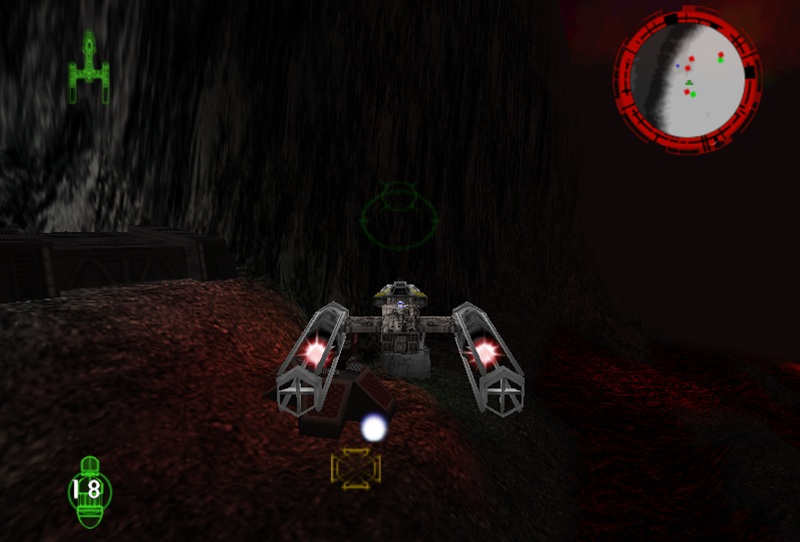
The craft all handle as they should. X-Wings are all-rounders and fire their four lasers fast enough to destroy missiles being shot out of turrets. Y-Wings move like a sleepy Hutt and can take a beating. Bombing with Y-Wings starts by setting a target on the ground, press again to release. This means you have to fly low to see the target appear, and if you turn, the reticule moves with your pitching and yawing nose, not just below the craft. This means you have to straighten up before the target, forcing you to do 'bombing runs'. In the Sullust mission it really makes you vulnerable, you start to feel like Yossarian in catch 22. In a mission with fast and nimble A-Wings the only way I could survive was with fast hit-and-run tactics. All of this is inherited from Star Wars canon (a lot of which is based around World War II) and goes to show how suited Star Wars is to videogames.
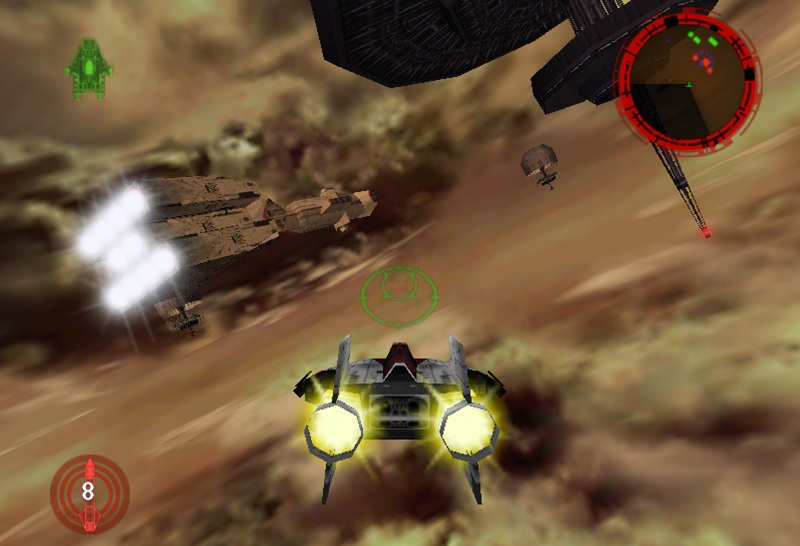
The cockpit modes are actually a viable and fun way to play, although not as immersive as in X-Wing. There are some other nice details. Lasers don't run out of energy completely, but do slow down if you don't give them a break. R2D2 is present in Luke's X-Wing or Y-Wing, and can repair them for you (unless you hear "I’ve just lost Artoo!" after firefight). There's no X-Wing style energy management, but you can switch S-foils to and from attack position. Closing your S-foils to get to a mission objective just in the nick of time and then opening them and starting your attack. It feels unnecessary, and fantastic.
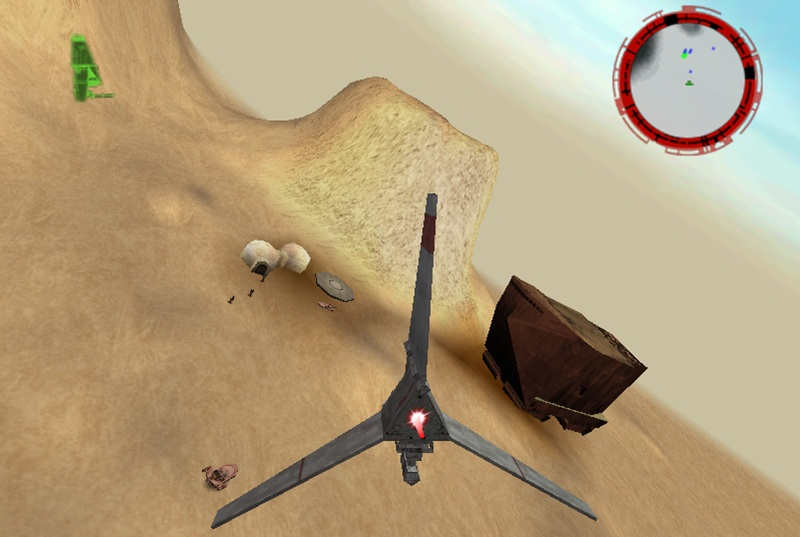
When you do have control, as mentioned you technically have 6 degrees of freedom but it's doesn't provide any advantage in in missions or dogfights (more on that later). Your ship maintains altitude and speed and (by default) orientation automatically, so you simply concentrate on pointing where you want to go and blasting things out of the sky. It's much easier than Descent or X-Wing, which is to the game's advantage. The flight ceiling is not very high, and often the same height as the tallest mountains on the map meaning you can't always fly over them to get where you want to be. But you are harder to hit up there, and it's equally exciting to hug the ground to avoid turbolaser fire.
Because of the simplified controls, something like a one-button barrel roll manoeuvre like in Star Fox 64 would have been good. And while we're at it, talking heads showing which pilot was talking would really have helped me get into the story and feel like part of a squadron instead of me and my NPC pals.
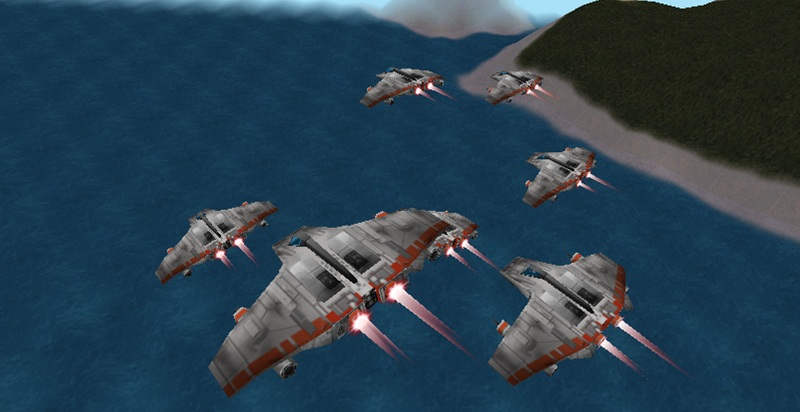
This flight model took a huge amount of time to get right, with the first year of development spent perfecting the X-Wing control scheme before other craft were added. Despite its genesis in the SotE Hoth level, the snowspeeders, or airspeeders, or speeders (all are correct it seems), were the last to go in. This is obvious when you play it, as the snowspeeder feels a bit disappointing compared to the starfighters or to the speeder in SotE, but I'll save those details for another article.
Complexity
The complexity that any player might be missing from the flight model is happily replaced by the levels and missions.
The missions feel alive, objectives change unexpectedly, they have multiple parts, and there are fun scripted story events as well. The usual mission types keep it fresh and varied and the logistical settings of some of them, rather than just big battles, make you feel like part of a larger war.
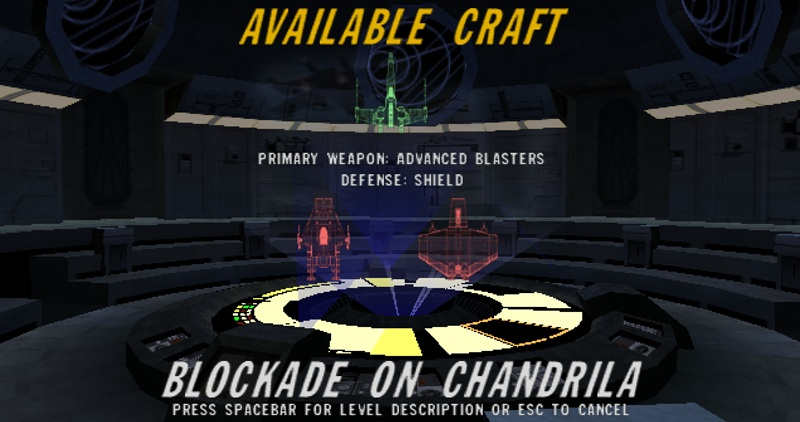
Your wingmen or other troops may have different objectives to you, and there is always plenty happening throughout the usually large open levels. While you fight in the sky, troopers and ground vehicles attack cities. Sometimes you may need to prioritise. Do you save your wingmates or do you stay on-mission? That's the choice Rogue Leader has, although you will often fail a mission if you try to do too much. This is not just a fun aspect to keep you engaged and on your toes, as 'Friendly saves' is one of the metrics used to grant you Gold, Silver, Bronze or no medal at all at the end of missions. Can you complete the mission and still save your friends, or civilians?
Those medals do a great job for replayability, including accuracy, time, number of deaths etc. Sometimes to achieve gold, or even just to complete the mission effectively, you do need to break off against your orders in order to get everything done. You are a rogue, after all.

Some gold medals are only realistic if played in a different ship, which you'll need to complete more missions to unlock for that level. You can also pick up hidden bonuses to get seeker missiles or cluster bombs for next mission.
All this makes it very rewarding of different styles and tactics. The official strategy guide mentions that in the first mission you can take down all 6 TIE Bombers with a single cluster bomb shot, if you get it just right. Combined with the scramjets if you've unlocked the V-Wing, and you will easily get the gold.
Enemy AI (Or Lack Of)
These mission challenges are good, because challenge does not come from the enemy AI. There are only two or three instances in the entire game of actual AI enemies in the form of TIE Interceptors that will hunt you down. All the other enemies in the game are on predetermined flight paths usually scouting around or bombing targets repeatedly. They will still shoot you if you're in range, but there is no dogfighting, just get to them and shoot them down.
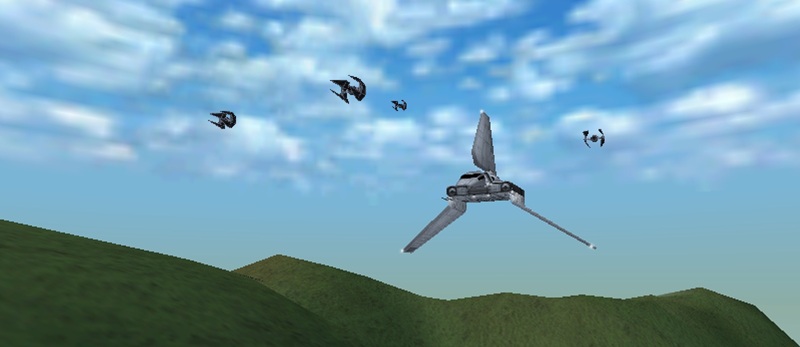
In practice this is not as bad as it sounds. It's essentially one big shooting gallery with you as the overpowered hero, and that's what Star Wars is all about. Luke taking down 10 TIE fighters is par for the course, and getting in a dogfight or a furball with the many enemies on each level would get tiring. Especially as if those few encounters are anything to go by, it doesn't quite work in this game. The AI TIEs stay very close to you, so trying to outmanoeuvre them, even in an A-Wing, is difficult. They won't fly straight long enough for a missile lock, so you'll be going in circles for a long time, or fly away fast and take their hits, coming back to hit them from a distance. It's just not balanced for it.
Despite the moving reticule (another tech solution that took a long time to implement), it is harder to lead enemies than in X-Wing. Better to get directly behind them whenever possible. Despite all this it does feel enough like dogfighting, and you'll be having so much fun you won't care.
The Techs Factor
To read or listen to interviews with Factor 5, especially series director Julian Eggebrecht, is to see obvious passion for technology. Even back in the Amiga days, F5 were always pushing the limits of hardware. They would use coding tricks and workarounds to avoid the limitations of the Amiga OS and push performance. For their Star Wars: Rebel Assault II port to Playstation, they reverse engineered Sony' FMV hardware so that they could combine the videos with 3D models and make it even more immersive. They even reverse engineered the SNES hardware and built their own dev kits instead of Nintendo's, something which could never happen today.
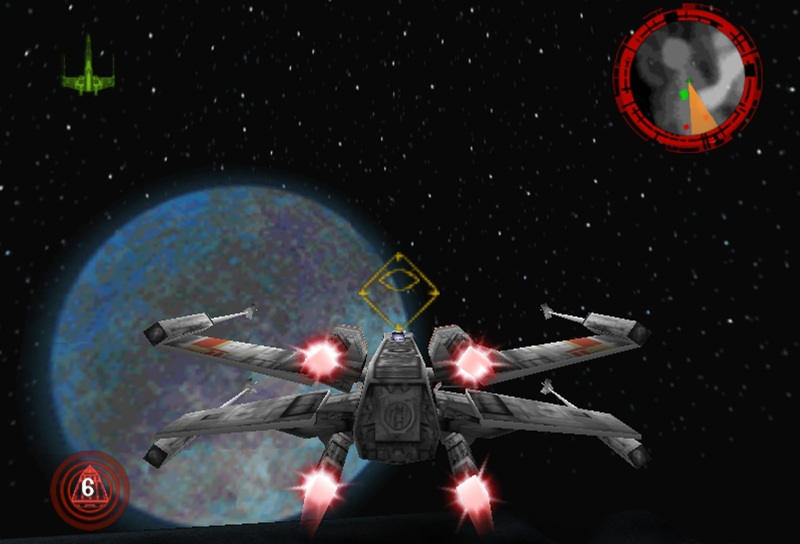
They would go on to create 2 Rogue Squadron Gamecube sequels, the spinoff Battle for Naboo (2000) as well as Lair on the PS3 which was repurposed from a cancelled Rogue Squadron game. All of these pushed the technical limits of consoles in some way and impressed particularly with graphics and sound.
It was even their technical prowess that allowed them to include one of the best kept secrets in gaming. With The Phantom Menace movie soon to be released, F5 had to fight to be allowed to include a secret Naboo Starfighter in the game. It could be patched in to the PC version later, but for the N64 it needed to stay hidden for 6 months. F5 had to provide a lot of assurance to LucasArts that their extreme efforts at obfuscating the model, menu texts and passcode could hold up against nosy hackers and devices like GameShark, and even then only two people knew the unlock code until it was publicised upon the movie's release.
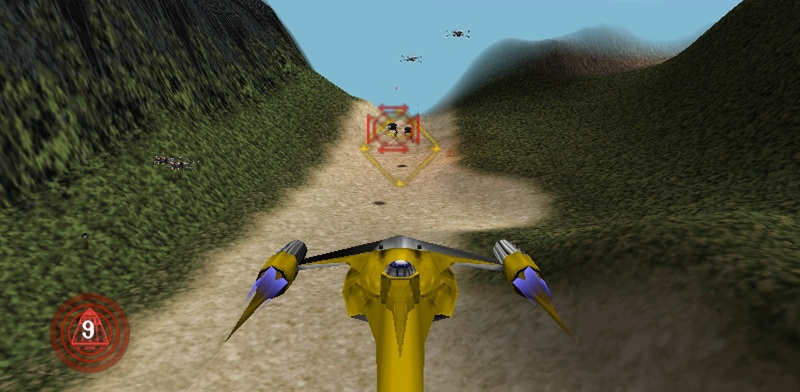
Factor 5 engineering is exceptional to the point that modern emulation developers have jokingly referred to them as ‘evil’. Their games are exceedingly difficult to emulate due to all the advanced techniques and hacks they invented to push the limit of what the consoles were able to do. Indeed F5 games have been some of the last games of entire generations of consoles to be successfully emulated.
Cutting Edge Audio
F5 weren't yet trusted with LucasrArts sacred Star Wars audio library, and Nintendo were very sceptical that F5 could pull off the advanced audio system they had coded for the game. The team was drawn to the N64 over Playstation because the streaming of their high-quality terrain assets would be too slow on a CD than cartridge. Unfortunately this meant sacrificing CD audio tracks, but F5 had created Musyx, an audio middleware technology that allowed them to use dynamic MIDI music to match the action on screen. The team is very proud of this and rightly so. Reviews praised the quality and amount of sound effects, music and voice work in the game, and the dynamic music system.
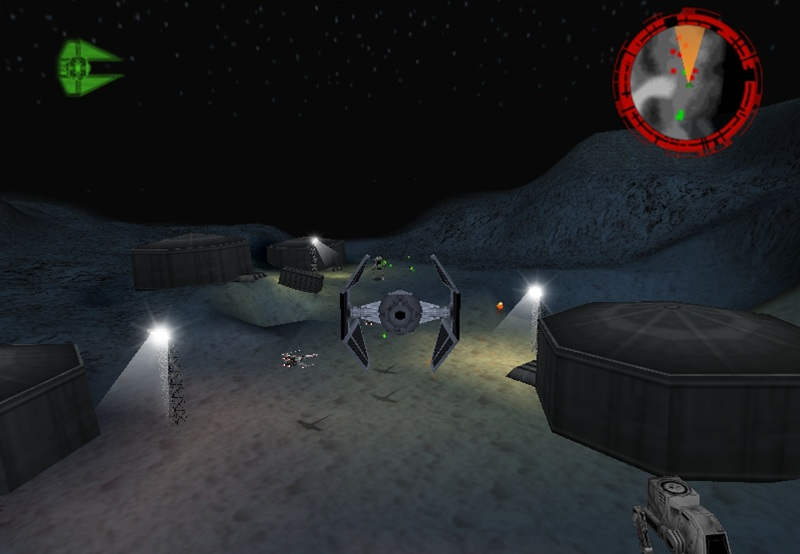
It worked out well. There is lots of voice work in menus and gameplay, lots of colourful radio chatter like from the movies. The voice actors are also a highlight. Olivia Hussey, star of TV, films and other Star Wars games plays imperial defector Crix Madine. Most notably she played Juliet in Franco Zeffirelli's Romeo and Juliet which I was made to watch in school. Sadly it was memorable to a class full of teenage boys not for her acting, but for it containing the first nude movie scene we had ever seen, which has since been the subject of law suits (and rightly so, in retrospect).
All other seasoned Star Wars and LucasArts voice actors including Bob Bergen, who often plays Luke Skywalker and starring in many Disney films (and was Wembley from Fraggle Rock!).
All of which is to say that their hard work paid off, and F5s tech was later licensed to Nintendo as the GameCube audio technology among others.
Maintain Visual Scanning
The same extreme talent and effort was put into graphics tech. F5's original pitch was based on high quality 3D fractal terrain generation based on the Fractalus idea, which would not work on the N64, so they started from scratch. Interviews mention the desire to break new ground for console graphics, and they did in many ways.
The development was done on devkits with the N64 memory expansion pak, and wouldn't work without it. In the last weeks of development the team got the game working without, but it looked so good with the increased resolution that they, along with Acclaim with Turok 2 (1998), they convinced Nintendo to release the Expansion Pak to consumers directly. Both games launched in December 1998 with Expansion Pak functionality, shortly after the Pak itself.
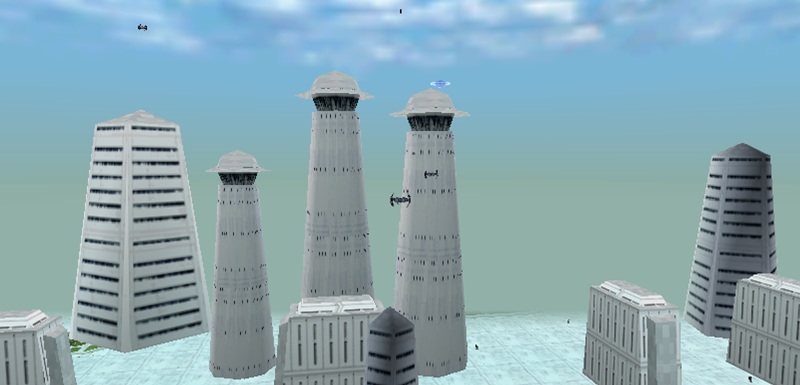
F5 managed to gain the trust of both LucasArts and Nintendo with their expertise and proof of concepts in many of these examples. Another is convincing Nintendo to allow them to code directly to hardware using proprietary Nintendo microcode, something only accessible to Nintendo and their close partners Rare. This allowed all manner of graphical and technical tricks and optimisations.
There was still heavy distance fog and by modern standards the scenery might seem sparse, but it was very impressive for its time thanks to these innovations and the willpower of F5. Real-time lighting from lasers and explosions, lots of little stormtroopers and many friendly and enemy vehicles onscreen in battles meant it was a thrilling ride.
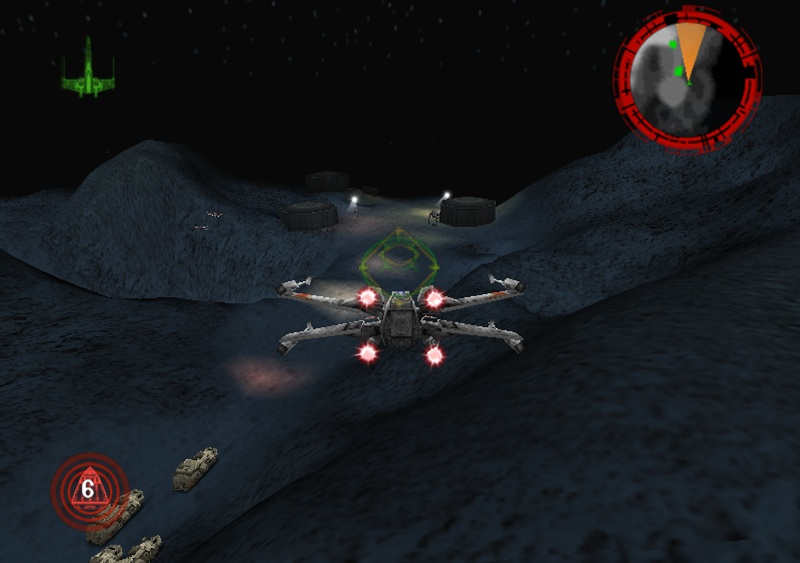
Technical Issues
While the two companies had cooperated many times before, this was the first high-profile game with The Big License, and it wasn't all plain sailing.
In the first place, LucasArts gave F5 the license "Begrudgingly" according to Eggebrecht, the product of years of working relationship. F5 moved from Germany for closer collaboration, and located themselves down the street from LucasArts. In an IGN interview with LucasArts' Dan Connors he says, "The whole time I've been here I've never seen a project that has shared as many resources as Rogue Squadron has."
Eggebrecht mentions in interviews that the game only came together in the last few weeks of crunch due to the unusual level of cooperation between teams, running ideas up the chain for the green light, and the technical issues facing the game. Technical solutions, the bonus level content, making the game even work without the Expansion Pak, among other things. Schmitt recalls that very late in the process a build showed up with the radar minimap, which LucasArts had no idea was being implemented. Eggebrecht says that in testing, players had no idea what to do and were getting lost in the open levels, it was generally unplayable without the radar system.
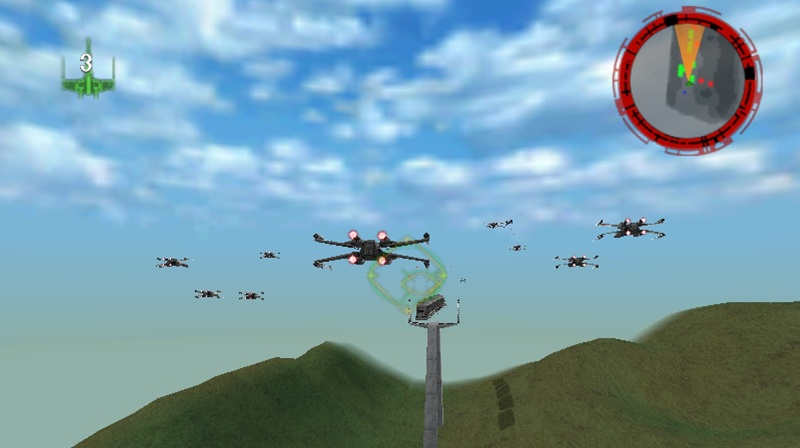
The radar works great, but communication issues like this caused some friction as it does among any co-working relationship. Mark Haigh-Hutchinson, described by Schmitt as "the nicest human on the planet”, would diffuse these situations and manage the teams' relationships.
F5 obviously loves tech and started out hacking away as a demo scene group. Eggbrecht tellingly admits that a licensed sequel they made for LucasArts Ballblazers Champions (1997) "was graphically gorgeous but sucks as a game" (although it did not review that badly). LucasArts' Schmitt speaks in interviews not about the engineering, but about the passion of the LucasArts team that kept them going from project to project to create great games.
We don't know exactly how much design was split between the companies, and not that F5 don't have a passion and talent for games which they clearly do. But just as George Lucas' limitations and collaborations are what made the original Star Wars special, combination of the two dev houses with two different priorities and approaches is perhaps what made Rogue Squadron a game that is still beloved, and still played, to this day.
